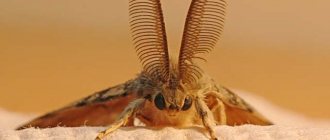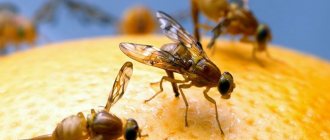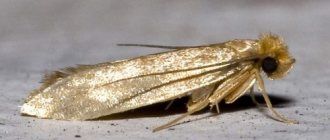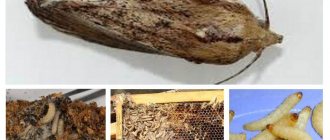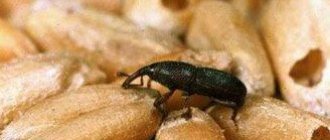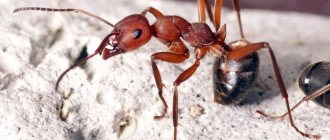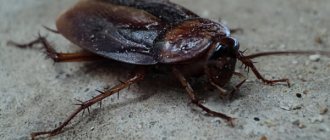Food moths are perhaps the most common food pest. What needs to be done to quickly rid kitchen cabinets and sideboards along with their contents? How to permanently protect your home from the appearance of this insect?
While the moth feels like a full-fledged mistress of the kitchen, something urgently needs to be done. Otherwise, she will soon fly off to explore the horizons of your living room, bedroom and other areas of the apartment. It is unlikely that a food moth will encroach on fur items in a closet, furniture or fabrics (for this it has distant “relatives” - fur moths, furniture moths and clothes moths), but to see it sitting on the ceiling and walls of different rooms is, at least, unpleasant . As a maximum, after an inspection of the kitchen, you will still have to frantically scour the auxiliary rooms, which are the pantry and the balcony, in search of cereals, dried fruits and dried mushrooms that were accidentally forgotten there. You probably already understand how to cultivate moths at home. It's time to get rid of her.
Where do moths come from in the kitchen and how to get rid of them?
The principle of combating kitchen moths should combine the following actions:
- complete liquidation of affected stocks;
- destruction of flying moths;
- processing of kitchen furniture.
We can immediately conclude that in order to eliminate the harmful insect, it will be necessary to develop a whole range of measures. It is worth noting that it is simply impossible to withdraw it with one action.
Check the products in the store; they should not contain even a hint of moth larvae or cobwebs. Check the expiration date and general appearance of the products.
Very often, when housewives see a moth in the kitchen, they begin to wonder where it came from. There is no need to guess - moths always enter the house with affected products from the store. These are mainly cereals, sugar, and less often pasta. Kitchen moths cannot simply fly in from the street; they multiply and spread through larvae. More often, products that have expired and have not been treated for pests are susceptible to damage.
The basis for the fight against moths is constant preventive measures and proper organization of food storage, rather than one-time destruction.
Precautionary measures
There is only one way to avoid a debilitating war with food moths - not to let the pest into the house. In addition, complete destruction of the parasite does not guarantee that food moth eggs will not appear in the apartment again. To prevent this from happening, you need to take preventive measures by following six rules.
- Examination. Carefully check the groceries when purchasing, periodically review your supplies in the future, and if necessary, dry them in the oven at low temperature.
- Sealed containers. Store grains and cereals in glass containers with tight-fitting lids.
- Low temperature. The larvae cannot tolerate low temperatures, so keep your groceries in the refrigerator.
- Ventilation. Don't forget to ventilate the kitchen.
- Safety nets. Place ventilation nets on the windows.
- Maintaining cleanliness. At least once a month, do a thorough cleaning of your apartment. This will help prevent the proliferation of parasites in time.
Do not purchase cereals by weight or in unsealed packaging. And if you have already bought it, then put the bag of grain in the freezer for a few days. The pest will no longer be able to reproduce.
Moths can appear in both a country house and an apartment. If you follow the described recommendations, then you will not have problems with how to remove food moths. In the future, do not forget about preventive measures and timely cleaning of the kitchen.
What does a food moth look like from a photo?
The food moth looks like a small butterfly, about 1 cm in size. The color is inconspicuous so that it can be easily hidden in products, from gray to brown with various inclusions.
What does food moth look like - in the photo
How long does a food kitchen moth live? Its lifespan is on average about three to four weeks, during which time it manages to lay a huge number of larvae.
Lifespan
Life cycle of a moth.
After mating, kitchen moths look for a moist, warm place where they will lay eggs. She needs 5-7 hours for fertilization and laying, after which she dies.
It takes 5-7 days from the maturation of the eggs to the appearance of the larvae. At one time, the female lays 50-100 eggs; they are very small, and it is almost impossible to notice their presence on food.
After emergence, the larva begins to eat food and throw waste into it. Cocoon formation is the final stage when cobwebs or balls appear in products.
The life cycle from egg to mating adult lasts 6-8 weeks.
Organization of food storage
As already noted, moths enter the house with spoiled food in the form of larvae, and only then turn into insects that fly. To combat it, you should follow the following rules and recommendations.
- Be sure to look through all food supplies in the cabinets. If any signs of cobwebs, larvae or adult insects are found, the entire stock should be destroyed. You should not buy a huge amount of food in reserve. The maggots may not appear during storage, but if an affected batch is received, the entire stock may be damaged and will have to be thrown out.
- It is better to purchase quality products from trusted brands. It's better to pay a little more than just throw everything away.
- When purchasing, you should carefully consider the packaging of the product. The slightest hint of cobwebs or lumps should be a signal that you should not purchase such products.
- After destroying contaminated food, it is imperative to clean the kitchen. Very often, moths begin to multiply further in food spilled on the floor or table.
- When searching for moth breeding sites, you should check every package, especially in the pantry. It is in such forgotten and nondescript packages that the main breeding ground for moths may be located.
It is worth noting that the name “kitchen moth” is a collective name for several species of butterflies belonging to the moth family. At home, the granary or flour moth is mainly found. A distinctive feature of the first individual is the presence of a light stripe on the brown wings.
Signs of appearance
The pest may not be immediately noticed; it camouflages itself very well. But some characteristic signs of the appearance of moths are still present from the first days, and subsequently they become more and more noticeable:
- Small gray-brown butterflies appeared chaotically flying in the kitchen and adjacent rooms. At first these are isolated cases, but if measures are not taken, they become more numerous. In addition to flying through the air, they can also be seen in bulk products, where they climb to lay eggs. They are clearly visible in light-colored flour and cereals.
- Inside kitchen cabinets, in corners, cracks, and sometimes just on the wall, small transparent white worms with a dark head - moth larvae - crawl. They can also be seen in food containers.
- In cereals or other similar products, cobwebs or small lumps of grains, dust and cobwebs with a worm inside have appeared - cocoons from which an adult individual emerges.
If at least one of these signs is noticed, it is necessary to act immediately, without waiting for the time when all the supplies in the kitchen are infected with this parasite.
Treating kitchen furniture against food moths
Such an event is simply necessary to destroy the larvae. After all, before the pupation process, they leave the food and spread throughout the entire territory. They can be found on walls, furniture doors and so on. For treatment, you can use various aerosols and means to kill ants and cockroaches. Today you can buy special products specifically against food moths and their larvae. Before treating furniture with chemicals and some time after, carry out wet cleaning.
After poisoning once, you should not hope that the insect will disappear. The emergence of larvae from food occurs at different times, and they can reappear in the kitchen within a couple of days. There are drugs that have a prolonged effect. They last much longer, but can be used exclusively for furniture, avoiding contact with products.
In the photo - food moth larvae
The use of chemicals alone will not have an effect unless a targeted fight is organized and the damaged products are not disposed of.
Routes of penetration
Even the cleanest housewife is unable to insure herself against the appearance of flour moths in the house.
- Moths can enter the home in flour purchased at the market or in a store, which was produced in violation of standards or stored under improper conditions.
- Winged moths can enter an apartment through a window or ventilation hole that does not have a mosquito net.
On a note!
You can minimize the likelihood of the spread of flour moths by heating the brought food in the oven or destroying insect eggs by freezing.
Destruction of food moth butterflies
There are other situations when all measures to destroy the larvae have been taken, the food is thrown away, and the moth is still flying. This should not be ignored; butterflies should also be destroyed, as they can lay larvae. Removing adult insects is easy. Chemicals may not be used. A simple fly swatter or even a house slipper will be enough.
The photo shows food moths in the kitchen. Get rid of moths so they don't spread again
To eliminate moths in warehouses and public catering establishments, special professional aerosols are used. Destruction is carried out on a weekend, followed by general cleaning.
How to recognize an enemy by sight?
Food moth is the common name for several types of moths (flour, cocoa, fruit and others). These small brown-beige insects happily settle in food warehouses, stores and other places where groceries are accumulated.
They are also attracted by the extensive food supplies in the apartments. Adult insects are not dangerous ; the life cycle of a butterfly is very short. But caterpillars live longer (up to one and a half weeks) and are amazingly voracious .
It is they who cause the main harm to products, not only by eating them, but also by leaving excrement, skin particles and other inclusions harmful to human health.
An adult butterfly can easily be confused with a clothes moth . It is very inconspicuous, has a protective coloring with brown, beige, silver-cream tones. The color of insect wings depends on the species. More information about where do moths come from in an apartment?
The caterpillars are whitish, with dark spots on the head . Insects prefer secluded dark corners; you can find them by sorting through food supplies.
Effective remedies for food moths in the kitchen
Modern means will help you get rid of food moths and their larvae, which must be used strictly according to the instructions and in conjunction with the cleaning and destruction of contaminated products. At the moment, there are such remedies for moths in the kitchen: sticky traps, sections, sprays. Do they all help? Let's consider the effectiveness of these drugs in order.
Food moth traps in the kitchen
A moth trap is a sticky sheet with a scent that attracts moths. A butterfly landing on this surface sticks tightly and dies. These traps are glued to the inside walls of kitchen cabinets.
The effect of such a product is designed to last 4-6 weeks, after which there will either be no space left on the trap, or it will no longer emit an odor and lose its sticky properties. The cost of such an insecticide is on average 150 rubles for two Velcro.
Reviews of glue traps for food moths
“Moths periodically appear in the kitchen, the food seems to be intact, I couldn’t find any larvae. I bought sticky anti-moth leaves at the supermarket, stuck them in the cupboards with cereals and pasta, and already got one moth. This product is not suitable for full control of insects; it is more likely for prevention.”
“An interesting remedy against moths, I glued such a plate on the kitchen shelf. Its peculiarity is that for humans it does not smell at all, but for male moths it is like a pheromone, they fly towards it headlong and stick. It is good to use for prevention so that moths do not multiply. A product of questionable effectiveness. The same sprays are more effective.”
Kitchen moth sections
Moth sections with and without scents are more suitable for storage cabinets. They mainly come in the form of a hanger hook. It will help little against food moths, as it does not affect the larvae. Valid for about 5 months, cost about 80 rubles per piece.
Reviews of sections against kitchen moths
“I put a moth section on the shelf with cereal, a couple of butterflies died, but the larvae all remained. I threw out all the cereals and treated them with Dichlorvos - more effect.”
Aerosol against kitchen food moths
Using a spray in the kitchen, especially to destroy moths whose larvae are hidden in food, is impractical and unsafe. If food is contaminated, destroy it immediately; you don't want to spray food on it. Aerosol spraying of cabinets is done in an empty kitchen where all food items are either covered or put away. After destroying the infected grains, wipe the shelves with a damp cloth, let them dry, and then spray the product. After this procedure, do not place open products directly on the treated surface! The cost of moth aerosol is around 150 rubles per bottle.
Reviews of anti-moth spray in the kitchen
“It’s been a long time since I used Raptor anti-moth spray, then the moth was on the shelf with towels, and it helped there. And then white worms appeared in the oatmeal in the kitchen - moth larvae, I realized that there was no point in splashing food on it. I threw out the porridge, wiped the box and popped it with this raptor just in case. It’s good that the moth did not have time to move into the neighboring boxes. A month has already passed - no prayer.”
